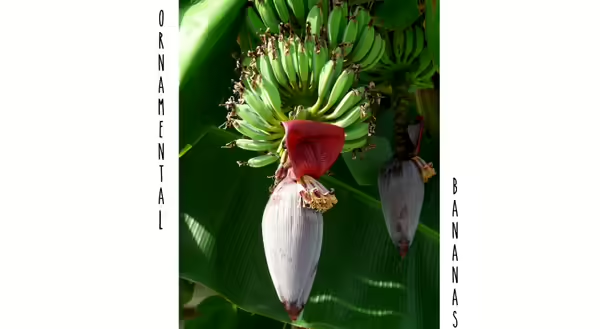
Written by Rhonda Ferree, retired horticulture educator
While enjoying coffee in the garden, I noticed that my largest ornamental banana is starting to flower. For many years I've been growing banana plants around my pool to give it a tropical feel in the summer. By autumn they have large stems with four- to five-foot-long leaves that sour to heights over ten feet tall.
Bananas are grown here for their ornamental value. Although some might bloom, we don't have a long enough growing season for fruit to develop and ripen.
Ornamental bananas come in a variety of leaf colors from green to variegated green and red.
I typically plant several solid green ones (Musa sp.) in the ground each summer, which I overwinter in my basement or heated garage. After the first frost, I cut off the leaves, leaving the main trunk and any suckers. I dig up as much root ball as fits in a five-gallon bucket and move them indoors. These plants will last the winter in a dormant state with very little water or light. In early spring I give them a sunny window and lots of water to boost their growth, before planting them outside again in early May. Watch my video on overwintering bananas at go.illinois.edu/ILRiverhortvideos.
I grow the more ornamental bananas in containers. Bananas come with burgundy streaked leaves (Rojo Blood Banana), blue-green leaves striped with red (Zebrina), terracotta-colored leaves with lime green splashes (Siam Ruby), and more.
Container grown bananas can be brought indoors and enjoyed as houseplants during the winter if you give them lots of light and humidity. Provide plants with the brightest location possible. Locate plants in high humidity areas if good light is available or group plants together. Grouping naturally raises the humidity in the vicinity. Expect some leaf loss and browning when they are brought indoors from their outdoor location.
Most bananas are tropical and will die quickly if left out in our winter cold; but, there is a hardy banana available called the Japanese Fiber Banana (Musa basjoo). Basjoo grows in plant hardiness zones 5 through 11. Central Illinois is in zone 5, so the plant might need a heavy mulch to survive a severely cold winter. Typically, the top will die back during the winter, and the roots survive to grow again in the spring. This banana has large bright green 6 feet long leaves and grows to 15-foot-tall.
Bananas are very easy to grow in our hot, humid summers. Give them full sun, and lots of water and the will grow so fast that you can almost watch them develop before your very eyes. They also multiply quickly by sending up suckers (pups) from the mother plant's roots.
For more information on growing bananas and other tropical plants, go to the University of Illinois Extension Tropical Punch website at http://extension.illinois.edu/tropicalpunch.
MEET THE AUTHOR
As horticulture educator, Rhonda Ferree inspired citizens in local communities to grow their own food and improve their home landscapes. She focused on high quality, impactful programs that taught homeowners how to create energy-efficient landscapes using sustainable practices that increase property values and help the environment.
After 30 years with University of Illinois Extension, Rhonda retired in 2018. She continues to share her passion for horticulture related topics as “Retro Rhonda” on social media.
ABOUT THE BLOG
ILRiverHort is a blog that helps people connect to nature and grow.